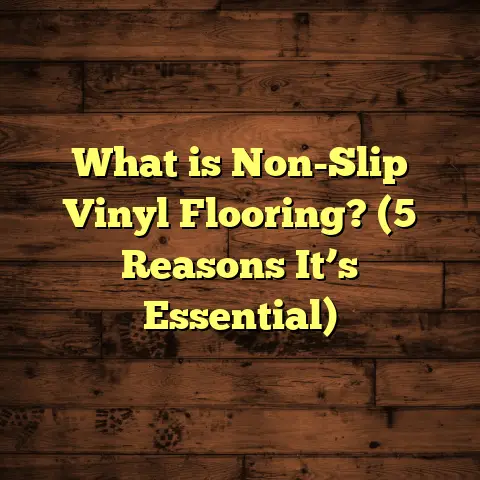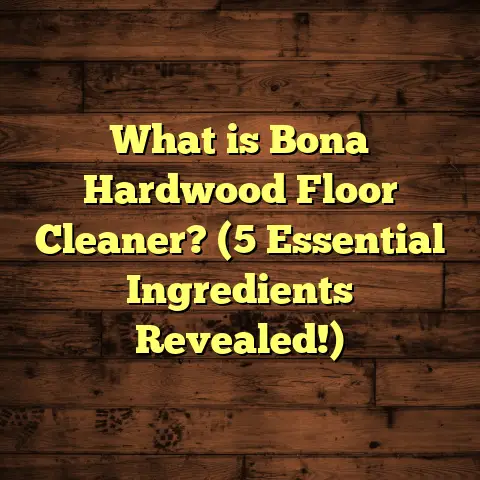What is Floor Score? (5 Key Benefits for Green Flooring)
A curious thing about flooring is that the very surface we walk on every single day can influence the air quality inside our homes—sometimes for better, sometimes for worse. It seems almost paradoxical: something so solid and immobile as a floor could actually be a source of invisible chemicals affecting our health. Yet, this is exactly where FloorScore comes into play—a certification that quietly helps protect your indoor air from harmful emissions without most people even realizing it.
What is FloorScore?
Let me explain what FloorScore really means. Imagine you are shopping for new flooring—say, vinyl planks or engineered hardwood—and you want to make sure that what you’re bringing into your home doesn’t release nasty chemicals that could irritate your lungs or worsen allergies. FloorScore is a certification program that tests and verifies that flooring products meet very strict indoor air quality standards.
More specifically, FloorScore measures the amount of volatile organic compounds (VOCs) that a flooring product emits. VOCs are chemicals that evaporate into the air at room temperature. They are found in many building materials, including paints, adhesives, and flooring products. Some VOCs can cause headaches, dizziness, allergic reactions, or even long-term respiratory problems.
The Resilient Floor Covering Institute (RFCI), an industry group, developed the FloorScore certification to ensure that flooring materials meet California’s Section 01350 standard, which is one of the toughest indoor air quality standards in the United States. Products undergo rigorous laboratory testing in a controlled environment. Samples are placed in chambers where sensors measure the concentration of VOCs released over time.
If the emissions stay below strict thresholds, the product earns the FloorScore label. This means it’s been independently tested and verified to be low-emitting and safe for indoor environments.
FloorScore applies to a wide range of flooring types: hard vinyl, linoleum, laminate flooring, engineered wood, carpets and carpet cushions, adhesives, and even underlayments. So when you see that little FloorScore logo on a flooring package or manufacturer website, it’s a sign that you’re choosing a product that supports healthier indoor air.
Why Does FloorScore Matter So Much?
You might ask yourself: Why should I care about this? Floors just sit there; how harmful can they be? This question comes up a lot when I talk to homeowners.
Well, here’s why it matters: We spend about 90% of our time indoors—at home, at work, or in school. The quality of indoor air affects our health dramatically. Unfortunately, indoor air is often more polluted than outdoor air because of the materials used inside buildings.
In my experience working with families who want greener homes, flooring often gets overlooked as a source of indoor pollution. Some materials release formaldehyde, benzene, and other harmful VOCs that can trigger asthma attacks or allergies in sensitive individuals.
According to data from the Environmental Protection Agency (EPA), VOC levels inside homes can be 2 to 5 times higher than outdoor levels. Flooring products are a big contributor because they cover large surface areas and are in close contact with the indoor air.
Using FloorScore-certified products reduces these harmful emissions significantly. This directly translates into better respiratory health for everyone living in the home—especially kids, elderly family members, or anyone with asthma or allergies.
5 Key Benefits of Using FloorScore-Certified Flooring
1. Healthier Indoor Air Quality
This is probably the biggest reason I recommend looking for FloorScore-certified products. These floors emit far fewer VOCs compared to conventional materials, meaning the air inside your home stays cleaner and safer to breathe.
I remember working with a young family whose toddler was constantly wheezing and had frequent asthma flare-ups. After switching their flooring to certified low-emitting vinyl planks marked with FloorScore, they noticed a marked decrease in symptoms within just a few weeks.
Studies back this up: Homes that use low-emitting materials see reductions in indoor VOC concentrations by 30-50%. This isn’t just about comfort—it can mean fewer doctor visits and less dependence on medications for respiratory conditions.
2. Supports Green Building Practices
If you’re involved in green building or remodeling projects aiming for certifications like LEED (Leadership in Energy and Environmental Design), WELL Building Standard, or Living Building Challenge, using FloorScore-certified flooring helps meet essential criteria related to indoor environmental quality.
I’ve helped several clients pursue LEED certification for their homes and commercial projects. Selecting certified products often earns valuable points toward certification without sacrificing design or durability.
For example, when renovating an office space for a wellness-focused company last year, including FloorScore-certified carpet tiles helped us satisfy LEED requirements for low-emitting materials. This made certification smoother and gave occupants confidence in their workspace’s healthfulness.
3. Enhanced Comfort and Peace of Mind
Beyond technical benefits, choosing healthy flooring affects how comfortable you feel at home. After installing FloorScore-certified engineered hardwood in my own living room, I noticed an immediate difference: less chemical odor during installation and no lingering smells afterward.
When I host guests now, many comment on how fresh the space feels compared to other rooms I’ve worked on. Knowing that the floor isn’t releasing harmful chemicals adds peace of mind I didn’t even realize I needed until I experienced it.
Comfort isn’t just about temperature or softness—it includes feeling secure that your surroundings aren’t silently harming you or your family.
4. Better Market Appeal and Resale Value
Believe it or not, homes with green-certified materials often attract more buyers and tend to sell faster with higher asking prices. More people today are aware of indoor environmental health risks and want assurance that their new home won’t compromise their well-being.
In my experience staging homes for resale, highlighting features like FloorScore-certified flooring has helped create a competitive edge. Buyers appreciate transparency about healthy materials being used and often ask about certifications when touring properties.
One realtor I spoke with said homes marketed as “green” or “healthy” were closing deals 20% faster in her area compared to similar homes without those features.
5. Reduced Environmental Impact
FloorScore certification encourages manufacturers to produce flooring with lower emissions not only during installation but throughout manufacturing processes as well. This aligns with broader goals of reducing pollution and conserving resources.
I worked closely with a factory that made certified resilient flooring products. Their journey to achieve FloorScore pushed them to reformulate adhesives and finishes so they released 40% fewer VOCs at the plant itself—making conditions safer for workers and nearby communities.
Choosing FloorScore products helps support companies committed to sustainable production and environmental responsibility—not just healthier homes.
How I Use FloorTally to Manage Flooring Projects
When managing flooring installations—especially those centered on green building goals—budgeting and material planning quickly get complicated. That’s where tools like FloorTally have become indispensable in my workflow.
FloorTally consolidates all cost calculations into one platform: local labor rates, material prices, waste percentages, installation times—you name it. This saves me hours of juggling spreadsheets or chasing down multiple vendor quotes.
For instance, during an eco-friendly office renovation last year, I used FloorTally to compare costs between various certified options quickly. It highlighted which materials fit the budget while maintaining green certifications like FloorScore.
It also visualized total project costs clearly so my client could see exactly where money was going—materials versus labor—and make informed decisions without compromising on quality or sustainability.
If you’re managing your own project at home or professionally, I suggest exploring tools like this to keep your finances organized while meeting all green goals efficiently.
Tips from My Experience Choosing and Installing FloorScore Flooring
- Verify Certification Carefully: Don’t rely on vague “low-VOC” claims without proof. Always ask for documentation showing FloorScore certification or equivalent lab results.
- Look Beyond Just Flooring: Adhesives, underlayments, sealants—all these components affect indoor air quality too. Choose certified low-emitting products across the board.
- Ventilate During Installation: Even certified products may release minor odors during installation. Keep windows open and use fans to clear out smells quickly for comfort.
- Plan for Waste: Cutting and fitting floors generates waste material—usually around 5-10%. Order extra material upfront to avoid surprises mid-project.
- Balance Style and Health: Many attractive options carry FloorScore certification—from wood-look vinyl planks to wool carpets—so you don’t need to sacrifice aesthetics for safer air quality.
- Hire Experienced Installers: Proper installation affects both durability and emissions—poorly installed floors may trap moisture or off-gas adhesives improperly.
Real-Life Case Study: A Green Home Makeover
One project I’m proud of involved helping a family renovate their aging home with a focus on healthier living environments. Their kids had severe allergies and asthma attacks triggered by dust and mold.
We chose engineered hardwood floors certified by FloorScore combined with low-VOC adhesives and moisture barriers beneath. After installation, the family reported fewer allergy flare-ups and improved overall comfort according to measurements from indoor air quality sensors we installed.
They also saw energy savings thanks to improved insulation below the new floors. This project showed me firsthand how much difference certified flooring can make—not only in health but also long-term home performance and comfort.
Diving Deeper Into VOCs: Why They Matter
You might ask: What exactly are VOCs? And how do they impact health?
VOC stands for volatile organic compound—a group of carbon-based chemicals that evaporate easily at room temperature. Common examples include formaldehyde, benzene, acetone, and many solvents used in manufacturing.
Some VOCs are harmless at low levels; others can irritate eyes, nose, throat, cause headaches or trigger allergic reactions. Long-term exposure has been linked to more serious conditions like asthma or even cancer in rare cases.
In flooring materials, VOCs come from resins, adhesives, finishes, plasticizers in vinyl floors, or glue used during installation. Even natural wood can off-gas if treated with certain finishes or stains.
FloorScore testing measures total VOC emissions over time—ensuring they remain below thresholds deemed safe by California’s Department of Public Health (CDPH). This standard is widely recognized as one of the toughest indoor air quality benchmarks globally.
How Testing Works: Inside FloorScore Laboratories
FloorScore certification isn’t just marketing fluff—it’s backed by rigorous science performed by third-party labs accredited by ANSI (American National Standards Institute).
Samples are placed in small chambers simulating typical room conditions: temperature around 77°F (25°C), relative humidity near 50%, no airflow except controlled ventilation. Air samples are taken at intervals over several days to measure emitted VOC concentrations in micrograms per cubic meter (µg/m³).
Testing looks at both total VOCs (TVOCs) and specific compounds regulated under Section 01350—like formaldehyde levels capped at 9 µg/m³ over 24 hours indoors.
Only when emissions remain below these limits does a product earn FloorScore approval valid for three years before re-testing is required.
This process gives me confidence recommending these products because it’s based on objective measurements rather than just manufacturer claims.
How FloorScore Fits Into Bigger Green Certifications
If you’re aiming for certifications like LEED v4 or WELL Building Standard v2 for your project:
- LEED: FloorScore-certified flooring contributes toward credits related to low-emitting materials under Indoor Environmental Quality (IEQ) categories.
- WELL: Using these products supports improved air quality prerequisites designed to promote occupant health.
- Living Building Challenge: Requires strict material ingredient transparency; many FloorScore products meet these stringent requirements due to their low VOC content.
These certifications help quantify your home’s sustainability efforts while improving occupant comfort—making choosing FloorScore flooring a practical step toward achieving them.
Personal Story: How Choosing Certified Flooring Changed My Perspective
When I first started installing floors years ago, I never thought much about VOC emissions. I focused mostly on durability and looks because customers cared about price and style first.
But after helping several families with allergy issues trace symptoms back to older floor materials emitting formaldehyde and plasticizers, I began researching healthier alternatives seriously.
My first project using only FloorScore-certified products was eye-opening—not only did clients report better health outcomes but installation went smoother with fewer complaints about odors or headaches from workers.
Since then, advocating for low-emission flooring became part of my mission because it truly improves lives beyond aesthetics or durability alone.
Common Questions About FloorScore Flooring
Q: Does FloorScore certification guarantee zero emissions?
No product emits zero VOCs—some very small amount always escapes—but FloorScore ensures emissions stay below strict safe limits established by scientific research.
Q: Can older floors be tested for VOC emissions?
Testing existing floors isn’t common practice but you can hire environmental consultants who perform indoor air sampling if concerned about off-gassing from old materials.
Q: Are there price differences between certified vs non-certified floors?
Sometimes certified floors cost slightly more due to added testing and manufacturing controls—but prices have come down as demand grows widely.
Q: Is installation more complicated with certified products?
Not really; installing certified floors follows normal procedures but choosing low-VOC adhesives or finishes recommended by manufacturers helps maintain IAQ benefits fully.
Q: Where can I find lists of FloorScore-certified products?
The RFCI website maintains an updated directory searchable by product type and manufacturer—great resource before buying decisions.
Breaking Down Costs: What Should You Expect?
Budgeting is one area where many people hesitate when choosing green-certified flooring because they assume it will be pricier upfront.
Here’s where my experience using tools like FloorTally has helped streamline cost planning:
- Material prices vary widely depending on type (vinyl tends to be cheaper than engineered hardwood or wool carpet).
- Labor rates fluctuate by region and installer expertise.
- Waste factor (material loss during installation) usually ranges from 5-10%.
- Additional costs might include subfloor preparation or removal of old flooring.
With FloorTally’s help, I enter local rates plus product choices then get a detailed breakdown showing where money will go before ordering anything. This transparency helps clients make smarter decisions balancing budget vs green goals without surprises later on.
Looking Ahead: The Future of Healthy Flooring
Sustainability trends continue pushing manufacturers toward safer ingredients and better transparency around emissions data. Advances like bio-based adhesives free of harmful solvents are becoming more common.
Some companies are integrating sensors inside floors monitoring air quality changes over time—a promising innovation giving real-time feedback on VOC levels within rooms.
As awareness grows among consumers demanding healthier homes rather than just pretty finishes or cheap prices, I expect certifications like FloorScore will become standard expectations rather than optional add-ons in coming years.
If you’ve made it this far with me—thanks for sticking around! Choosing healthy flooring might seem like just one piece of your home improvement puzzle but it impacts daily life more than most people realize. From protecting your family’s lungs to supporting sustainable industry practices—FloorScore-certified products have earned their place as smart choices for green flooring projects everywhere.
Got questions about your own flooring project? Need advice on budgeting or finding certified installers who know these products well? Just ask—I’m here to share what I’ve learned over years helping people create healthier homes one floor at a time.





